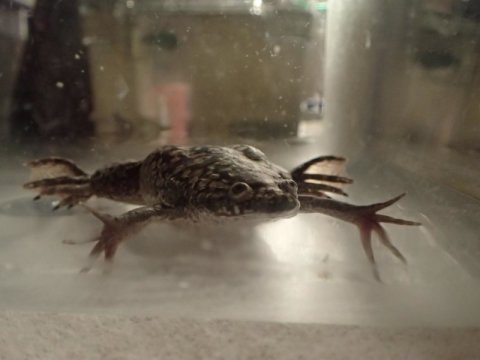An African clawed frog, or Xenopus laevis, is pictured swimming in a tank before amputation for the experiment. Photo by Celia Herrera-Rincon/Tufts University
Nov. 7 (UPI) -- A team of scientists from Tufts University have developed a way to regenerate severed frog legs, which they say is an effort to move one step closer to regrowing human limbs.
The findings were published Tuesday in the journal Cell Reports.
Using a 3D printer, researchers at Tufts produced a bioreactor from silicon, then filled it with hydrogel. After that, they tied hydrating silk proteins to the hydrogel to encourage repair and regeneration. Finally, they added progesterone, which is known to heal nerves, blood vessels and bone tissue.
Researchers then amputated the legs of adult aquatic African clawed frogs, Xenopus laevis, creating experiment treatment, control and sham groups to measure the effects of the bioreactor.
The team then stitched the bioreactor to the area of amputated limbs on frogs in the experimental group, removing it after 24 hours. After nearly 10 months, the scientists observed the bioreactor triggered "paddle-like" formation that looked more fully-formed than with organic regeneration.
"The bioreactor device created a supportive environment for the wound where the tissue could grow as it did during embryogenesis," Michael Levin, a developmental biologist at the Allen Discovery Center at Tufts and senior author of the study, said in a press release. "A very brief application of bioreactor and its payload triggered months of tissue growth and patterning."
The researchers analyzed the RNA sequencing and transcriptome of the frog, concluding the bioreactor changed gene expression within cells at the amputation area. The researchers also said the progesterone in the bioreactor suppressed the frog's immune system and scarring responses, which actually aided the regeneration process.
"At best, adult frogs normally grow back only a featureless, thin, cartilaginous spike," Levin said. "Our procedure induced a regenerative response they normally never have, which resulted in bigger, more structured appendages. The bioreactor device triggered very complex downstream outcomes that bioengineers cannot yet micromanage directly."
Now the team will shift its focus to replicating these results in mammals, along with developing bioelectric processes to induce spinal cord regeneration and tumor reprogramming.
"In both reproduction and its newly discovered role in brain functioning, progesterone's actions are local or tissue-specific," said first author Celia Herrera-Rincon, a neuroscientist in Levin's lab at Tufts University. "What we are demonstrating with this approach is that maybe reproduction, brain processing, and regeneration are closer than we think."
"Maybe they share pathways and elements of a common -- and so far, not completely understood -- bioelectrical code," Herrera-Rincon said.















